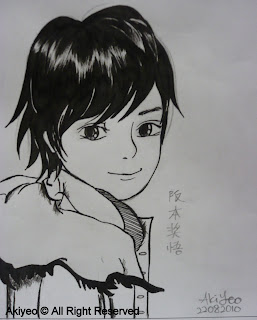
虽然,马来西亚是长夏的国家,天上的星星还是随着四季在转变的。这几晚,因为,天气特别的晴朗,我住的地方光害还没有严重到连一颗星都看不到的程度,所以,我可以很清楚地看到天上现在挂着的是天蝎座。
小时候父亲教我很多的东西。因为他是老师的关系,我的学校功课,一直到初中的科目,都是他和母亲教的。他还教我书法,下象棋, 打乒乓,羽球,骑脚车,等等。 可是,他们很严厉,军人似的指导。我并不是那种聪明的孩子,所以,我常常就挨骂,挨打。。。打是疼,骂是爱。。。^ ^我是这么想的。
但是,父亲也把很多自然界的事物也教我了。在兄妹当中,我最小,所以,非常爱撒娇。每次,除了读书外就喜欢粘住父亲。所以,他把很多他知道的关于这个世界的一些奇妙事物教给了我。其中观星是我最喜欢的。^ ^
很奇妙的,对学习这些自然界的东西,教一次就懂了,比念ABC容易了许多!^ ^以前的家,前面是一片未开发的树林,所以,光害很少,很容易就看到漫天的星星。我们没有特别的望远镜,只是学习用肉眼去看。满天的星星象是宇宙赐给人类的礼物一样,非常的美丽!
父亲教我看的第一个星座是猎户座。因为,地球转动的关系,我学会了第二个星座,天蝎座。两个永远都不会碰面的星座。然后,在搬到新的屋子时,因为没有树林的遮挡,我学会了南十字星和北斗七星(大熊星座和小熊星座)
在马来西亚,也实在看不到太多其它的星座。
 好兴奋呀!对我来说,这是宝一样的能力。这是和父亲最快乐的沟通方式。我当时也相信,我若在森林迷路了,也不用太过担心,因为,星星会告诉我方向。^ ^ 我们是在宇宙当中的其中一种生物,那么浩瀚的宇宙容纳了我们的存在。我们每天都可以从星群看到过去呀!我常想,今天我看到的光芒可能源头早已不在了。星星距离我们有几千几万光年,我们看到的都是他的过去。在他消失的几千年后,我们才发现它已经消失了。这对我来说有些许的悲哀。但,转个念头,它消失的几千年当中,我们还是一直注视着它,一直都记得它,那也很不错呀!
好兴奋呀!对我来说,这是宝一样的能力。这是和父亲最快乐的沟通方式。我当时也相信,我若在森林迷路了,也不用太过担心,因为,星星会告诉我方向。^ ^ 我们是在宇宙当中的其中一种生物,那么浩瀚的宇宙容纳了我们的存在。我们每天都可以从星群看到过去呀!我常想,今天我看到的光芒可能源头早已不在了。星星距离我们有几千几万光年,我们看到的都是他的过去。在他消失的几千年后,我们才发现它已经消失了。这对我来说有些许的悲哀。但,转个念头,它消失的几千年当中,我们还是一直注视着它,一直都记得它,那也很不错呀!就像父亲那样,当我们看懂,了解他时,已经发鬓双白了。所以,到今天为止,有机会时,我还是会跟父亲一起观星。虽然,看的还是一样的星座,还是一样的一片天空,但,心境已然不同。^ ^
猎户座
 |
| 猎户座 |
猎户座最佳观测日期为十二月上旬至四月上旬。出现时自东南方升起,经天顶后由西南方落下。通常利用排成一直线的腰带三星当其辨别指针,在光害不大的天空易清晰可见。主体由4颗亮星组成一个大四边形,在四方形的中央,有3颗星排成一条直线。人们便把这个四边形想象成昂首挺胸的猎人身体,四边形中的3颗星则是猎人的腰带。。。在Little DJ这部电影里提到,3颗排成直线当中最右边的那颗星对下,还隐藏着一颗星星。因为,不容易被看见,所以,要是能看见那颗星,然后许愿的话,梦想就会实现呢。^ ^
天蝎座
 |
| 天蝎座 |
在一年的中段,在日落后的南方天空,天蝎座看上去特别明显。夏天晚上八九点钟的时候,南方离地平线不很高的地方有一颗亮星,这就是天蝎座α星(心宿二)。因为这时候南边低空中多是些暗星,所以它非常显着。找到了这颗星,天蝎座的其它部分就不难认出来了。
南十字星座
星座中主要的亮星组成一个“十”字形,从这个“十”字形的一竖向下方一直划下去,直到约4倍于这一竖的长度的一点就是南天极。在北回归线以南的地方皆可看到整个星座。14世纪航海家郑和七下西洋时,曾用这个星座来导航。北半球大部分地区都看不到此星座.
 大熊星座,小熊星座
大熊座是北方天空中最明亮、最重要的星座之一。著名的北斗七星就在这个星座里。其实,小熊星座尾部的最后一颗星就是北极星。而北极星也同时存在于大熊星座里。北极星并不正好在北极点上,它和北极点还有1°的距离, 只不过再没有别的星比它更接近北极点了,所以它就近似地被人们视为北极点。
大熊星座,小熊星座
大熊座是北方天空中最明亮、最重要的星座之一。著名的北斗七星就在这个星座里。其实,小熊星座尾部的最后一颗星就是北极星。而北极星也同时存在于大熊星座里。北极星并不正好在北极点上,它和北极点还有1°的距离, 只不过再没有别的星比它更接近北极点了,所以它就近似地被人们视为北极点。 如果我们站在地球的北极,这时北极星就在我们头顶的正上方。在北半球其它地方,人们看到北极星永远在正北方的那个位置上不动。而且,由于地球的自转和公转,北天的星座看上去每天、每年都绕北极星转一圈。尤其是北斗,勺口指向北极星,并绕着它旋转,不知倦怠,永不停歇。古人对此大有感触,在《易经》中写下了“天行健,君子自强不息。”这样意味深长的话。
如果我们站在地球的北极,这时北极星就在我们头顶的正上方。在北半球其它地方,人们看到北极星永远在正北方的那个位置上不动。而且,由于地球的自转和公转,北天的星座看上去每天、每年都绕北极星转一圈。尤其是北斗,勺口指向北极星,并绕着它旋转,不知倦怠,永不停歇。古人对此大有感触,在《易经》中写下了“天行健,君子自强不息。”这样意味深长的话。
Cliff Edwards
When You Wish Upon a Star
When You Wish Upon a Star
When you wish upon a star
Makes no difference who you are
Anything your heart desires
Will come to you
If your heart is in your dream
No request is too extreme
When you wish upon a star
As dreamers do
Fate is kind
She brings to those to love
The sweet fulfillment of
Their secret longing
Like a bolt out of the blue
Fate steps in and sees you through
When you wish upon a star
Your dreams come true




























